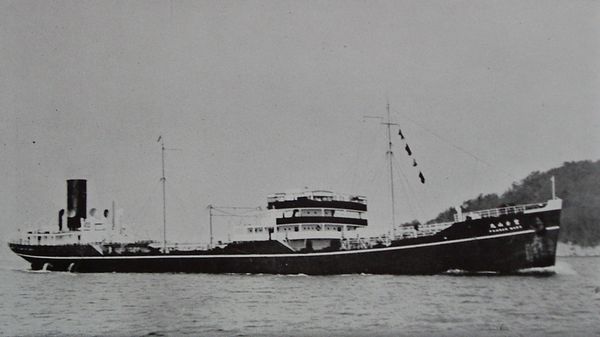Kawasaki-type Oiler on:
[Wikipedia]
[Google]
[Amazon]
The was a type of oiler of
 * The London Naval Treaty forced shrinkage of a budget to the Imperial Japanese Navy (IJN). And it meant cooling of the Japanese shipbuilding industry worlds. The
* The London Naval Treaty forced shrinkage of a budget to the Imperial Japanese Navy (IJN). And it meant cooling of the Japanese shipbuilding industry worlds. The
Image:Toa Maru.jpg, Iino Lines ''Tōa Maru''
Image:Kyokuto Maru.jpg, Iino Lines ''Kyokutō Maru''
Image:Toho Maru.jpg, Iino Lines ''Tōhō Maru''
Image:Toei Maru-1941.jpg, ''Tōei Maru'' in February 1941
Image:Shinkoku Maru-1941.jpg, ''Shinkoku Maru'' in September 1941
Image:Nippon Maru-1943.jpg, ''Nippon Maru'' in June 1943
Image:Kyokuto Maru inWartime.jpg, ''Kyokutō Maru'' and carrier ''Hiryū'' in May or June 1942
Image:Japanese cruiser Tone taking-over fuel from an oiler in 1944.jpg, ''Kokuyō Maru'' and cruiser ''Tone'' on 17 June 1944
Japan
Japan ( ja, 日本, or , and formally , ''Nihonkoku'') is an island country in East Asia. It is situated in the northwest Pacific Ocean, and is bordered on the west by the Sea of Japan, while extending from the Sea of Okhotsk in the north ...
, serving during the 1930s and World War II
World War II or the Second World War, often abbreviated as WWII or WW2, was a world war that lasted from 1939 to 1945. It involved the vast majority of the world's countries—including all of the great powers—forming two opposin ...
. They do not have an official class name.Iino Lines called ''Tōa Maru'' class, Kawasaki Line called ''Tatekawa Maru'' class, Nittō Mining called ''Nichiei Maru'' class, and more... Therefore, this article uses common class names. And, this type has some variants. This article handles them collectively.
Background
 * The London Naval Treaty forced shrinkage of a budget to the Imperial Japanese Navy (IJN). And it meant cooling of the Japanese shipbuilding industry worlds. The
* The London Naval Treaty forced shrinkage of a budget to the Imperial Japanese Navy (IJN). And it meant cooling of the Japanese shipbuilding industry worlds. The Great Depression
The Great Depression (19291939) was an economic shock that impacted most countries across the world. It was a period of economic depression that became evident after a major fall in stock prices in the United States. The economic contagio ...
more accelerated it. The IJN wanted to update their ''Notoro''-class oilers and ''Ondo''-class oilers, because these oilers were not able to chase the aircraft carrier.
* In 1929, the IJN decided their combat ship (battleship, aircraft carrier, cruiser, destroyer, submarine and torpedo boat) fuel only to heavy crude oil. And, the IJN was paid a grant to newly build large/high-speed tankers.
* In 1931, two marine transportation companies built the tankers which the IJN wanted. One was the 9,900 tons/17.5 knot '' Teiyō Maru'', the other the 9,500 tons/18.8 knots '' Fujisan Maru''.
* The IJN was satisfied by ''Fujisan Maru''. The IJN recommended building of the improved ''Fujisan Maru'' class tanker.
Construction
* In 1932, the ordered two tankers ''Tōa Maru'' and ''Kyokutō Maru'' to theKawasaki Shipbuilding Corporation
is the shipbuilding subsidiary of Kawasaki Heavy Industries. It produces primarily specialized commercial vessels, including LNG carriers, LPG carriers, container ships, bulk carriers, oil tankers, as well as high speed passenger jetfoils. In ...
. In total 17 tankers were built with the same basic drawings, until 1943.
* All sisters participated to World War II
World War II or the Second World War, often abbreviated as WWII or WW2, was a world war that lasted from 1939 to 1945. It involved the vast majority of the world's countries—including all of the great powers—forming two opposin ...
. However, they were not able to survive at all.
Ships in classes
''Tōa Maru'' class
* First production model of the ''Kawasaki''-type tankers. Their success gave courage to other steamship companies.''Tatekawa Maru'' class
* Second production model. They were built by the same as ''Tōa Maru'' class drawings. However, their details were different by steamship company which they placed an order for (example: ''Nippon Maru'' removed one dry cargo hold). Narrow sense of the ''Kawasaki''-type tanker was until the ''Kyūei Maru''. ''Kyūei Maru'' was equipped surplus stocks of the ''Argentina Maru'' machinery.''Nisshō Maru'' class
* One of the variant of the ''Kawasaki''-type tankers. The Mitsubishi used many curves to reduce her air friction strength.''Kuroshio Maru'' class
* One of the variant of the ''Kawasaki''-type tankers. ''Kuroshio Maru'' was equipped with a La-Mont boiler. Her design was used for the ''Type 1TL wartime standard ship''.''Akatsuki Maru'' class
* One of the variant of the ''Kawasaki''-type tankers. The Harima Zōsen used the Sulzer diesel.Service
Characteristics
Photos
Footnotes
Bibliography
*Tashirō Iwashige, ''The visual guide of Japanese wartime merchant marine'', (Japan), May 2009 *Monthly Armor Modelling special issue, ''"Navy Yard Vol.8 Tora! Tora! Tora!"'', Dainippon Kaiga (Japan), July 2008 *Kunio Matsumoto, ''The Lives of the Japanese Tankers'', (Japan), January 1995 *Shinshichirō Komamiya, ''The Wartime Convoy Histories'', (Japan), October 1987 *The Maru Special, ''Japanese Naval Vessels No.53, "Japanese support vessels"'', (Japan), July 1981 *''60 Years of the Iino Lines'', (Japan), June 1959 *''50 year History of Harima Zōsen'', Harima Zōsen Corporation, November 1960 *''Photo Gallery of the Japanese merchant ships'', Shutei Kyokai Shuppanbu (Japan), August 1950 * {{DEFAULTSORT:Kawasaki World War II naval ships of Japan World War II tankers Oilers Auxiliary replenishment ship classes